To tune your 2025 Nissan GT-R for unmatched speed, focus on upgrading the engine with the latest turbocharger and airflow enhancements, such as high-flow intakes and exhaust systems, to maximize horsepower. Reprogram the ECU and TCU for optimized shift points and response, while fine-tuning the AWD system for better grip. Improve handling with adjustable suspension and aerodynamic parts, then consider aftermarket software for real-time tuning. Keep exploring these options to open your car’s full potential.
Key Takeaways
- Reprogram the ECU and TCU with advanced tuning software to optimize fuel, boost, and ignition maps for maximum power.
- Upgrade intake and exhaust systems, including high-flow filters and full stainless steel exhaust, to improve airflow and reduce turbo lag.
- Fine-tune turbo boost pressure, ignition timing, and fuel delivery for peak performance and responsiveness.
- Adjust suspension and aerodynamic components to enhance grip, stability, and handling at high speeds.
- Use real-time data logging and remote tuning tools for precise calibration and continual performance enhancements.
Enhancing the Engine for Maximum Power Output

To maximize the 2025 Nissan GT-R’s power output, engineers have focused on refining its engine architecture and integrating advanced performance technologies.
The 3.8-liter VR38DETT V6 engine, a modified version of the VQ engine, features a compact design that improves weight distribution and handling. It employs plasma transferred wire arc sprayed cylinder bores, reducing friction and boosting efficiency.
Dual overhead camshafts with variable intake valve timing optimize airflow, enhancing power. Turbocharging with IHI twin-turbochargers operating over 0.7 bar boost pressure delivers quick, substantial power gains while minimizing lag. Incorporating performance-enhancing technologies such as direct fuel injection and variable valve timing further increases efficiency and responsiveness.
The hybrid wet/dry-sump lubrication system guarantees reliable performance under high g-force conditions, while precise fuel management and emissions controls maintain efficiency.
These innovations work together to produce up to 600 horsepower in the NISMO variant. Tuning techniques can further unlock the GT-R’s full potential.
Upgrading the Transmission for Faster Shifts
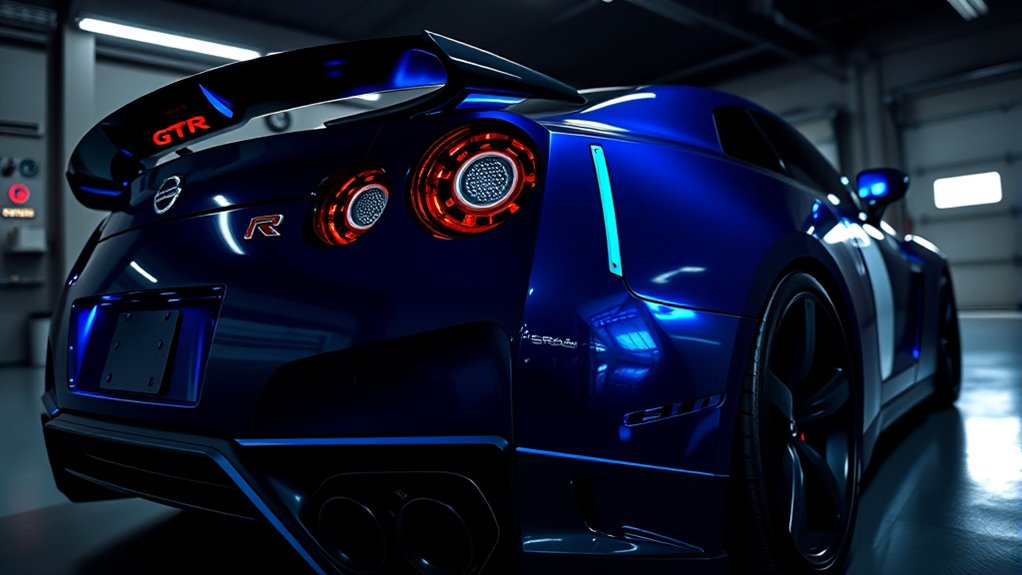
Enhancing the transmission system of your 2025 Nissan GT-R is essential for achieving even faster shift times and maximizing performance. Upgrading key components and tuning software can markedly improve responsiveness and acceleration. Consider these upgrades:
Upgrading your GT-R’s transmission system boosts shift speed, responsiveness, and overall performance for an exhilarating drive.
- Reprogram the transmission control unit (TCU) for optimized shift timing.
- Replace clutch materials with high-performance options to handle increased torque.
- Adjust gear ratios for quicker engagement and smoother power delivery.
- Install paddle shifters for manual control, enabling more precise and rapid gear changes.
Advanced transmission tuning techniques can further optimize shift speed and durability. These modifications work together to reduce shift lag, improve handling, and keep your transmission cool during aggressive driving. Proper transmission tuning is also crucial for maintaining the longevity of upgraded components and ensuring consistent performance. Additionally, employing automotive scan tools can help monitor and fine-tune transmission parameters effectively.
The result is a more seamless, high-performance driving experience that reveals the GT-R’s full potential on street or track.
Optimizing the All-Wheel Drive System for Better Traction

Optimizing the all-wheel-drive system of your 2025 Nissan GT-R can markedly improve traction and handling, especially during high-performance driving. By fine-tuning power distribution and leveraging the system’s adaptive features, you enhance grip and stability. Adjustments to torque split, response times, and drive modes—R-mode, Normal, and Save—allow you to tailor performance to conditions. The system’s integration with VDC and sensors ensures continuous real-time adjustments, maintaining ideal traction. Familiarity with automotive repair basics helps you understand how system components work together to optimize performance, and understanding tuning techniques can further refine your vehicle’s capabilities.
Tuning the Suspension for Superior Handling and Stability
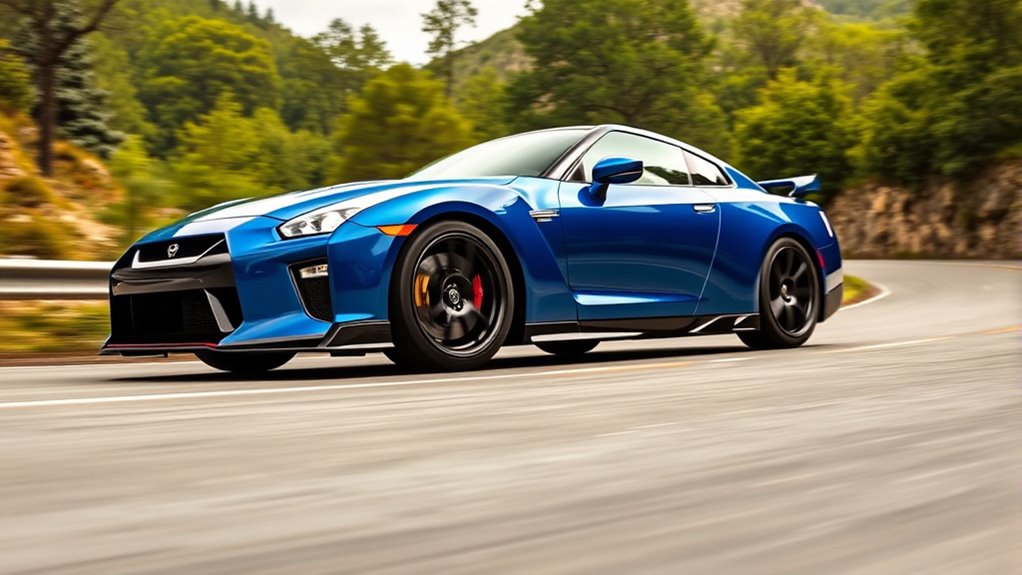
Achieving superior handling and stability in your 2025 Nissan GT-R starts with precise suspension tuning. You can enhance performance by focusing on key adjustments:
- Optimize suspension geometry by adjusting upper and lower arm bushes, increasing caster angle for better front grip and reduced understeer. Proper geometry adjustments can significantly influence vehicle stability and overall control.
- Upgrade to CNC-machined mounts and arms to ensure precise alignment and minimize flex under load, boosting stability.
- Implement advanced suspension components like Bilstein and Eibach dampers, which balance compression and rebound for a smoother ride.
- Use coilovers with adjustable settings to tailor spring rates and ride height, maximizing tire contact and chassis responsiveness. These customizable features allow for precise tuning to match driving preferences and conditions.
These improvements deliver sharper cornering, increased grip, and consistent handling across varied driving conditions. The R35 GT-R is described as very stable and predictable across various tracks, and these suspension adjustments will help maintain that stability even in demanding scenarios.
Refining Aerodynamics to Increase Downforce and Reduce Drag

Refining the aerodynamics of your 2025 Nissan GT-R is essential for boosting downforce and cutting drag, which directly improve high-speed stability and cornering grip. Using lightweight carbon fiber components like front air dams, rear diffusers, and adjustable rear wings enhances aerodynamic efficiency. These elements manage airflow to increase downforce and reduce turbulence. Active aerodynamic systems dynamically adjust elements such as splitters and spoilers based on speed and driving conditions, optimizing grip without sacrificing straight-line speed. Chassis tuning and body shape refinement further reduce drag while increasing downforce. The car’s aerodynamic design has been meticulously engineered to balance these factors for optimal performance. The table below illustrates key aerodynamic components and their functions:
| Component | Purpose |
|---|---|
| Front Air Dams | Reduce lift, improve steering response |
| Rear Diffusers | Accelerate airflow, boost rear downforce |
| Adjustable Rear Wings | Fine-tune downforce versus drag for conditions |
Customizing Electronic Systems for Performance Driving
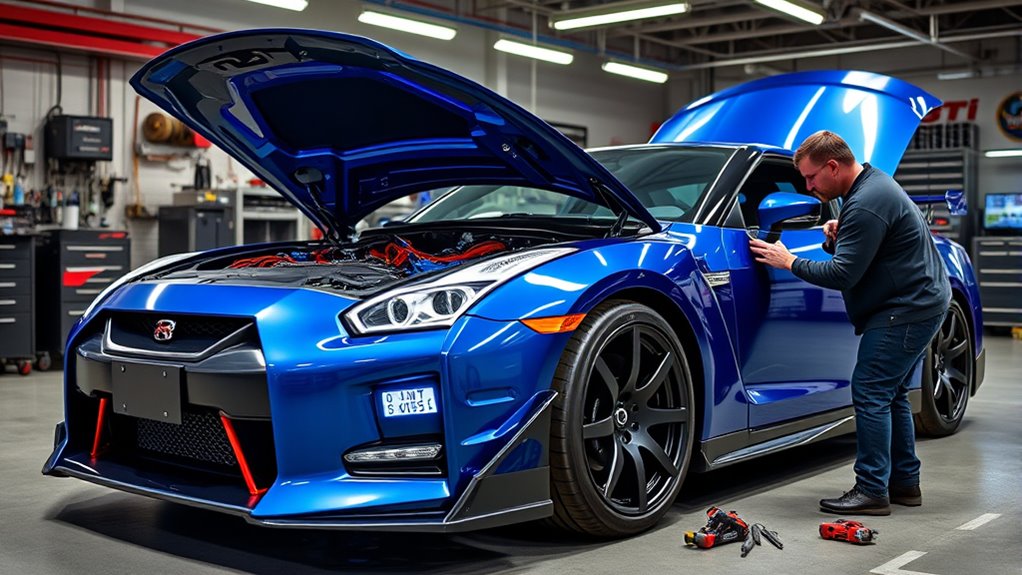
Customizing the electronic systems of your 2025 Nissan GT-R can considerably enhance its performance capabilities. You can optimize power delivery, traction, and stability by fine-tuning key components. Here are four essential upgrades:
Enhance your 2025 Nissan GT-R’s performance by fine-tuning its electronic systems for optimal power, traction, and stability.
- Engine Management Software – Use tools like MoTeC C127 to adjust engine parameters for maximum output. The new GT-R’s advanced electronics allow for more precise tuning, unlocking additional horsepower and responsiveness. industry-leading technology
- ECU Mapping – Fine-tune engine maps to improve efficiency and responsiveness across driving conditions.
- Boost Pressure Control – Implement systems to precisely manage turbocharger pressure, boosting performance.
- Ignition System Upgrades – Upgrade to high-performance spark plugs and coils for reliable ignition during aggressive driving.
These modifications guarantee your GT-R responds instantly, maintains high efficiency, and delivers unmatched speed on the track. Proper electronic tuning is vital for revealing your car’s full potential.
Selecting and Installing Performance Exhaust and Intake Upgrades
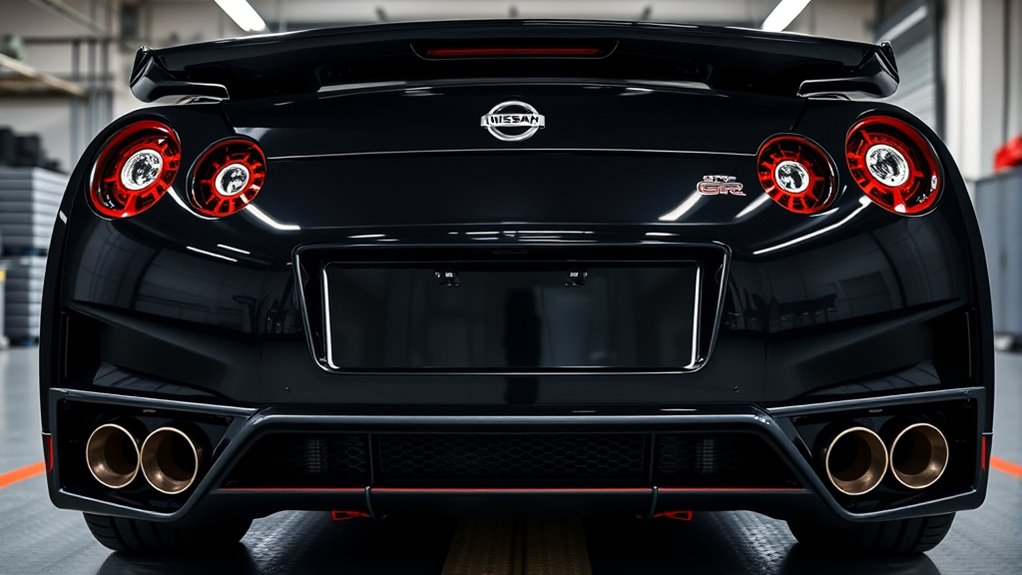
Enhancing your 2025 Nissan GT-R’s performance isn’t just about electronic tuning—it also involves upgrading the exhaust and intake systems to maximize airflow and power.
Start with high-quality exhaust options like AMS Performance’s 90mm midpipes, which optimize flow while maintaining street legality, or the ETS 4″ stainless steel full exhaust paired with Jotech’s Stage 1 kit, supporting over 900 HP. For more aggressive setups, decat downpipes increase top-end power but require motorsport use. Incorporating brewing techniques can help you understand airflow dynamics and optimize your setup for maximum performance.
Intake upgrades, such as 3″ aluminum intakes with K&N filters, boost airflow and throttle response, especially when combined with high-flow air filters and dual cold-air systems. These modifications work synergistically with ECU recalibration, reducing turbo lag and liberating significant horsepower gains, pushing your GT-R closer to its ultimate speed potential. Additionally, understanding the importance of airflow can help you optimize your setup for maximum performance.
Implementing Aftermarket Tuning Software for Boosted Performance
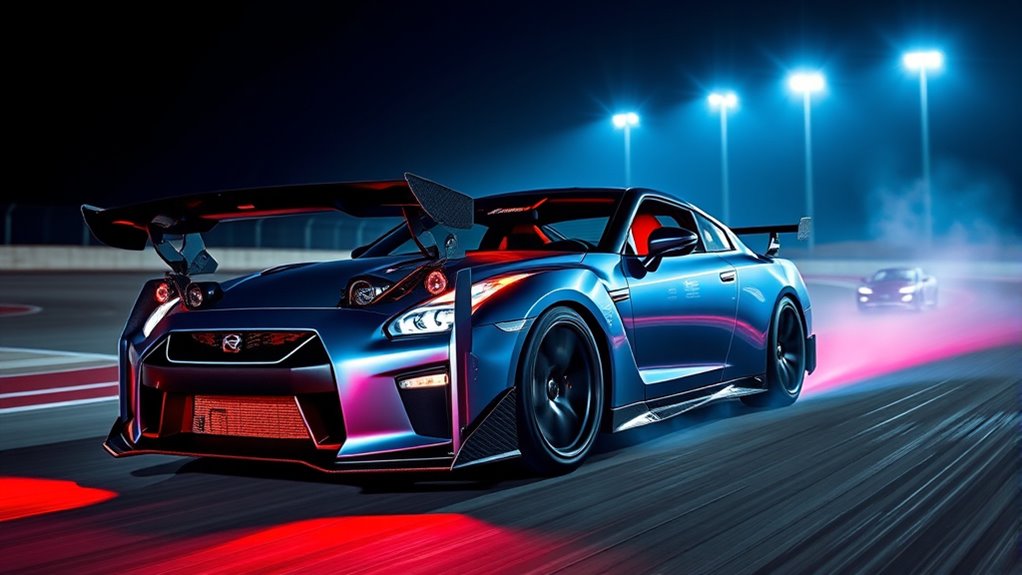
Implementing aftermarket tuning software is a crucial step to access your 2025 Nissan GT-R’s full boosted performance. With the right tools, you can optimize power, responsiveness, and safety while maintaining reliability.
Here are key options to contemplate:
- COBB Accessport V3: Offers real-time monitoring, map switching, and adjustable traction/launch control for precise tuning.
- EcuTek ProECU: Provides Bluetooth data logging and map adjustments compatible with iOS and Android devices.
- ECU Edit and UPREV: Open-source and alternative solutions for OEM ECU modifications and custom tuning.
- Remote tuning kits (e.g., AdminTuning): Enable ECM/TCM customizations, multiple maps, and fail-safes for overboost and knock protection.
These software options empower you to tailor your GT-R’s performance safely and effectively.
Frequently Asked Questions
What Are the Best Aftermarket ECU Tuning Options for the GT-R?
You’re asking about the best aftermarket ECU tuning options for your GT-R. You can consider the Syvecs S7Plus for extensive management, COBB AccessPort V3 for real-time monitoring, or EcuTek with ECU Connect for Bluetooth control.
Visconti tuning kits offer adjustable features, while Litchfield’s ECU solutions optimize shift points and acceleration. Each provides unique benefits, so choose based on your desired power, drivability, and tech preferences.
How Can I Maximize the Gt-R’S Horsepower Safely?
Think of maximizing horsepower like fine-tuning a high-performance engine. You can safely boost power by upgrading turbochargers, strengthening internal components, and optimizing engine management.
Additionally, improve cooling systems and install high-quality intercoolers to prevent overheating. Pair these with transmission remapping, stronger driveshafts, and a limited-slip differential.
Regular maintenance and safety upgrades, like brakes and chassis reinforcement, make certain you enjoy the extra power without risking reliability or safety.
What Suspension Settings Deliver Optimal Balance for Track Use?
You want to find the best suspension settings for track use, right? Start by lowering the stance to improve stability and reduce understeer. Adjust ride height for better aerodynamics and weight distribution.
Fine-tune damping with Bilstein DampTronic shocks for a balance between comfort and performance. Optimize camber and toe angles for sharp cornering.
Use adaptive dampers for real-time adjustments, ensuring your GT-R stays responsive and stable at high speeds.
Which Aerodynamic Upgrades Offer the Best Performance Gains?
You’ll get the best performance gains by upgrading to a full carbon fiber aerodynamic kit, including a front lip, side skirts, rear diffuser, and trunk spoiler, for ideal airflow and downforce.
Add an active rear wing and adjustable splitter to fine-tune aerodynamics at various speeds.
Combining these components reduces drag, improves stability, and enhances high-speed cornering, giving you a noticeable edge on the track or street.
How Do I Prevent Engine Overheating During Aggressive Tuning?
They say prevention is better than cure. To stop engine overheating during aggressive tuning, keep your coolant levels topped up and inspect hoses regularly for damage.
Guarantee your radiator fins are clean, and the radiator cap functions correctly. Monitor your temperature gauge constantly, and verify that the thermostat, water pump, and fans operate properly.
Implement heat shields, regulate boost pressure, and stay alert to early signs of stress or heat buildup.
Conclusion
By tuning your 2025 Nissan GT-R, you’re releasing its true potential, pushing speeds beyond 200 mph with precision handling. Did you know that a well-tuned GT-R can shave seconds off lap times, making it a formidable track contender? With the right upgrades, you’ll enjoy unmatched acceleration, grip, and aerodynamic efficiency. Keep refining your setup, and you’ll experience a driving experience that’s not just fast, but exhilarating and uniquely yours.










